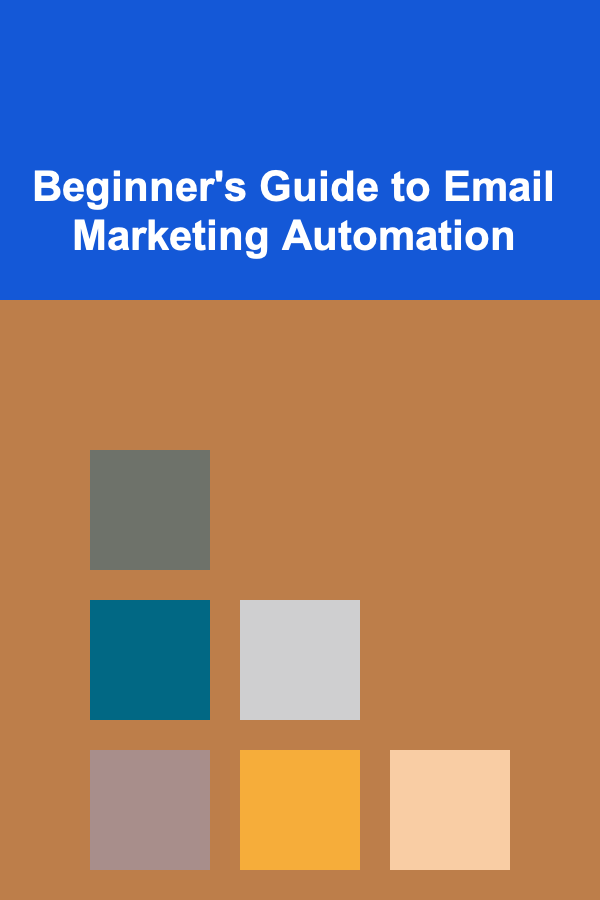
Beginner's Guide to Email Marketing Automation
ebook include PDF & Audio bundle (Micro Guide)
$12.99$6.99
Limited Time Offer! Order within the next:

Email marketing is one of the most effective tools for reaching and nurturing your audience. However, as your list grows, managing emails manually can become overwhelming and inefficient. This is where email marketing automation comes into play. Automation allows you to send timely, relevant emails to your subscribers without having to manually craft each message.
In this guide, we'll dive into the fundamentals of email marketing automation, how to set it up, and tips for optimizing your automated campaigns.
What is Email Marketing Automation?
Email marketing automation refers to the use of software and tools to send emails automatically based on pre-defined triggers and workflows. With automation, you can send personalized emails to your subscribers at the right moment without manual intervention. These emails can range from welcome messages to abandoned cart reminders to re-engagement campaigns.
Why You Should Use Email Marketing Automation
- Save Time: Automation allows you to send large volumes of emails without manually composing each one.
- Enhance Personalization: Automated emails can be highly personalized based on subscriber behavior, making your emails more relevant and engaging.
- Increase Engagement: By sending timely emails based on user actions, you can keep your audience engaged and build stronger relationships.
- Improve Conversion Rates: With the right automation strategy, you can drive more conversions by sending targeted emails to users at the right stages of the customer journey.
- Scale Your Efforts: As your business grows, email marketing automation helps you scale your efforts without increasing the amount of manual work required.
Key Components of Email Marketing Automation
Before diving into how to set up email marketing automation, it's essential to understand the core components involved in the process:
1. Email List Segmentation
Segmentation is the practice of dividing your email list into smaller groups based on shared characteristics or behaviors. This allows you to send more targeted, relevant emails to different groups of people. Common segmentation criteria include:
- Demographics: Age, gender, location, etc.
- Behavior: Past purchases, website activity, email engagement, etc.
- Customer Journey Stage: New subscribers, leads, repeat customers, etc.
Effective segmentation ensures that your subscribers receive emails that are tailored to their needs and interests, improving the chances of engagement and conversion.
2. Triggers
Triggers are events or actions that automatically activate an email in your workflow. For example, a trigger could be when a user subscribes to your email list or when they abandon their shopping cart. Common email triggers include:
- Welcome Emails: Sent when someone subscribes to your list.
- Abandoned Cart Emails: Sent when a user adds items to their cart but doesn't complete the purchase.
- Birthday Emails: Sent to wish your subscribers a happy birthday.
- Re-engagement Emails: Sent to subscribers who haven't interacted with your emails for a while.
3. Email Workflow
An email workflow is a series of automated emails sent to a subscriber over a period of time based on their interactions. The workflow can be designed to guide subscribers through the customer journey, from awareness to conversion.
For example, a simple workflow for a new subscriber might look like this:
- Email 1: Welcome email sent immediately after sign-up.
- Email 2: Follow-up email sent 3 days later with more information about your products/services.
- Email 3: Special offer sent a week later to encourage a purchase.
4. Personalization
Personalization refers to tailoring your emails to individual subscribers, making the content feel more relevant to them. This can range from using their first name in the subject line to offering personalized product recommendations based on their past behavior.
Email marketing automation tools allow you to automate personalization at scale, ensuring each email feels unique to the recipient.
5. Analytics and Reporting
Tracking the performance of your automated emails is critical to understanding what works and what doesn't. Metrics such as open rates, click-through rates, conversion rates, and unsubscribe rates will help you evaluate the effectiveness of your campaigns. With email marketing automation tools, you can easily track these metrics and optimize your emails for better performance.
How to Set Up Email Marketing Automation
1. Choose the Right Email Marketing Automation Platform
To get started with email automation, you'll need an email marketing platform. There are several options available, ranging from beginner-friendly tools to more advanced platforms. Some popular email marketing automation tools include:
- Mailchimp: Known for its ease of use, Mailchimp is great for beginners and offers features like drag-and-drop email design, segmentation, and basic automation workflows.
- ActiveCampaign: A more robust platform with advanced automation features, including multi-step workflows, lead scoring, and deep CRM integration.
- ConvertKit: Ideal for creators and small businesses, ConvertKit offers powerful automation and tagging features with a focus on simplicity.
- HubSpot: A full-fledged CRM platform that offers advanced email automation as part of its suite of marketing tools.
Choose a platform that aligns with your business goals, budget, and level of expertise.
2. Build Your Email List
Before you can automate emails, you need a list of subscribers. Here are a few strategies to help you build your list:
- Offer Incentives: Provide a valuable resource, like an eBook, discount, or webinar, in exchange for email sign-ups.
- Use Opt-In Forms: Place email opt-in forms on high-traffic pages of your website, such as the homepage or blog posts.
- Leverage Social Media: Promote your email sign-up forms through your social media channels to reach a wider audience.
- Host Contests or Giveaways: A great way to encourage people to join your email list is by offering prizes in exchange for sign-ups.
3. Set Up Your First Automated Email Campaign
Once your email list is built, it's time to create your first automated email campaign. Follow these steps:
a. Define the Goal of Your Campaign
Start by setting clear objectives. Do you want to welcome new subscribers, encourage a purchase, or re-engage inactive customers? Knowing your goal will help you design an effective email workflow.
b. Create Your Email Sequence
Based on your goal, design a sequence of emails that will be sent over time. Make sure each email serves a specific purpose, such as:
- Introducing your brand
- Providing value or educational content
- Offering a special promotion or discount
c. Set Triggers
Determine which events will trigger the automated emails in your sequence. For example, if you're sending a welcome series, your trigger will be the user signing up for your email list. If you're sending abandoned cart reminders, the trigger will be the user abandoning their cart.
d. Design and Personalize Your Emails
Design your emails to be visually appealing and easy to read on any device. Use your email marketing automation platform's tools to personalize the emails, adding the recipient's name, specific product recommendations, or relevant offers based on their behavior.
e. Test Your Workflow
Before launching your campaign, test it to ensure everything works as expected. Verify that triggers are firing correctly, emails are being sent at the right times, and all links and images are working.
f. Launch Your Campaign
Once you've tested your workflow, it's time to launch! Monitor your campaign's performance and make adjustments as needed.
4. Optimize and Iterate
After your email campaign has been running for a while, it's crucial to track the performance metrics and make improvements:
- Subject Line: A compelling subject line increases open rates. Test different subject lines to see which one performs better.
- Content: Are your emails engaging and valuable to the recipients? If not, consider revising the content to better resonate with your audience.
- Timing: Test different sending times to identify when your audience is most likely to engage.
- Frequency: Ensure you're not sending too many emails, which could lead to unsubscribes, or too few, which could result in missed opportunities.
Best Practices for Email Marketing Automation
- Keep Emails Relevant: Don't send generic emails. Use automation to deliver highly relevant content based on user behavior and preferences.
- Segment Your Audience: The more you segment your audience, the more personalized and relevant your emails will be. This improves engagement and conversion rates.
- A/B Test: Continuously test different elements of your emails, from subject lines to email copy and images, to find what works best.
- Provide Value: Whether you're offering a discount or educational content, always make sure your emails provide something of value to the recipient.
- Maintain Consistency: Regularly send valuable emails to keep your audience engaged. However, be mindful not to overwhelm them with too many messages.
Conclusion
Email marketing automation is a powerful tool that can help you save time, personalize your communications, and increase engagement with your audience. By setting up automated workflows, segmenting your list, and continuously optimizing your campaigns, you can create a seamless and effective email marketing strategy that drives results. Start small, test your efforts, and gradually scale your automation to create an impactful email marketing program that nurtures and converts your subscribers into loyal customers.
Reading More From Our Other Websites
- [Toy Making Tip 101] Creative Wood Toy Designs You Can Make with Kids at Home
- [Polymer Clay Modeling Tip 101] Creative Pasta Shapes You Can Make with a Polymer Clay Extruder
- [Home Renovating 101] How to Plan a Whole-House Renovation Without Stress
- [Home Storage Solution 101] How to Organize Your Laundry Room with Efficient Storage Solutions
- [Personal Care Tips 101] How to Choose Between Mechanical and Chemical Facial Scrubs
- [Personal Care Tips 101] How to Choose Brow Gel for a Natural Everyday Brow Look
- [Home Space Saving 101] How to Save Space by Streamlining Your Home's Layout
- [Paragliding Tip 101] Route Planning: Using GPS to Find the Perfect Thermals
- [Survival Kit 101] First Aid Kit for Beginners: A Complete Guide to Packing Your Emergency Kit
- [Mindful Eating Tip 101] Seasonal Snacks with Intention: Mindful Bites for Anytime Cravings

How to Build a Chocolate Business from Home: A Beginner's Guide
Read More
How to Use Wedding Photography to Make Money
Read More
How to Utilize Wall Space for Maximum Storage
Read More
Analyzing Your Competition for Profit Insights
Read More
How to Use the Eisenhower Matrix to Save on Overwhelm and Expenses
Read More
How to Maximize Your Social Security Disability Benefits
Read MoreOther Products

How to Build a Chocolate Business from Home: A Beginner's Guide
Read More
How to Use Wedding Photography to Make Money
Read More
How to Utilize Wall Space for Maximum Storage
Read More
Analyzing Your Competition for Profit Insights
Read More
How to Use the Eisenhower Matrix to Save on Overwhelm and Expenses
Read More